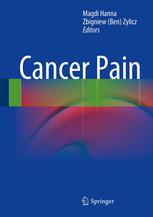مشاهده سبد خرید “Management of Bleeding Patients 2016” به سبد خرید شما اضافه شد.
Cancer Pain 2013
دانلود کتاب پزشکی درد سرطان
دسته: انکولوژی, پزشکی, پزشکی بالینی, طب داخلی, عمومی, مدیریت درد
ناشر:
Springer London
| نویسنده |
Magdi Hanna, Zbigniew (Ben) Zylicz |
|---|
| تعداد صفحهها |
286 |
|---|---|
| نوع فایل |
|
| حجم |
5 Mb |
| سال انتشار |
2013 |
89,000 تومان
دانلود ۳۰.۰۰۰ کتاب پزشکی فقط با قیمت یک کتاب و ۹۹ هزار تومان !
توضیحات
برنامه درد سرطان راهنمای جامع و کاربردی برای مدیریت درد در بیماران مبتلا به سرطان ارائه می دهد. با شروع بحث در مورد مسائل جاری در کنترل درد سرطان، فصول اولیه توضیحی واضح و مختصر از سندرمهای درد سرطان، درک اخیر مکانیسم پاتوفیزیولوژیک و پیشرفتهای اخیر در ایجاد مدلهای پیشبالینی درد سرطان ارائه میدهند. . این کتاب انتخاب گسترده و بهبود یافته ای از مدیریت درد سرطان در عمل بالینی از جمله استفاده از داروهای مخدر و غیرافیونی و نقش رویکردهای غیردارویی برای کنترل درد را به خواننده ارائه می دهد. فصلهای بعدی به چالشهای خاص کنترل درد، مانند درد ناگهانی، درد سرطان عصبی، و همچنین درد مرتبط با درمان سرطان میپردازد که تا همین اواخر به طور کامل مورد توجه قرار نگرفت. مسائل اخیر در مورد عوارض جانبی جدید داروهای مخدر مزمن مانند پردردی و سمیت عصبی توضیح داده شده و بهترین شیوه ها برای به حداقل رساندن یا اجتناب از آنها ذکر شده است. هدف این کتاب همچنین کمک به رفع نیاز آموزشی کلی برای پزشکان جوان و همچنین پزشکان مراقبت های اولیه با برجسته کردن ابزارهای موجود و اهمیت مداخلات اولیه برای درد در استراتژی کلی درمان سرطان است.
توضیحات(انگلیسی)
Cancer Pain provides a comprehensive, practical guide to the management of pain in cancer patients. Beginning with a discussion of current issues in the control of cancer pain, the initial chapters provide a clear, concise explanation of cancer pain syndromes, an up-to-date understanding of the pathophysiological mechanism and recent developments in creating pre-clinical cancer pain models. The book offers the reader the wide and improved options for management of cancer pain in clinical practice including the use of opioid and non-opioid drugs and the role of non-pharmacological methods in pain control. Subsequent chapters address particular challenges in pain control, such as breakthrough pain, neuropathic cancer pain, as well as pain associated with cancer treatment which, until recently, has not been fully appreciated. Recent issues relating to new adverse side effects to chronic opioid medications such as hyperalgesia and neurotoxicity are explained, and best practice to reduce or avoid them is stated. The book also aims to aid in the overall educational need for young doctors as well as established primary care physicians by highlighting the available tools and the importance of early pain interventions in the overall cancer treatment strategy.




